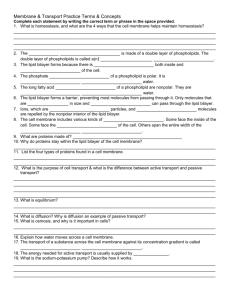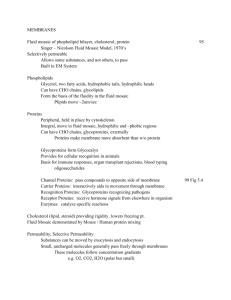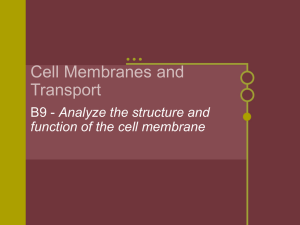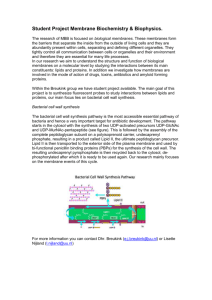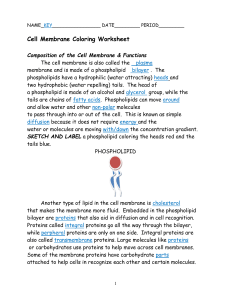Cell Membrane - Millbury Public Schools
advertisement
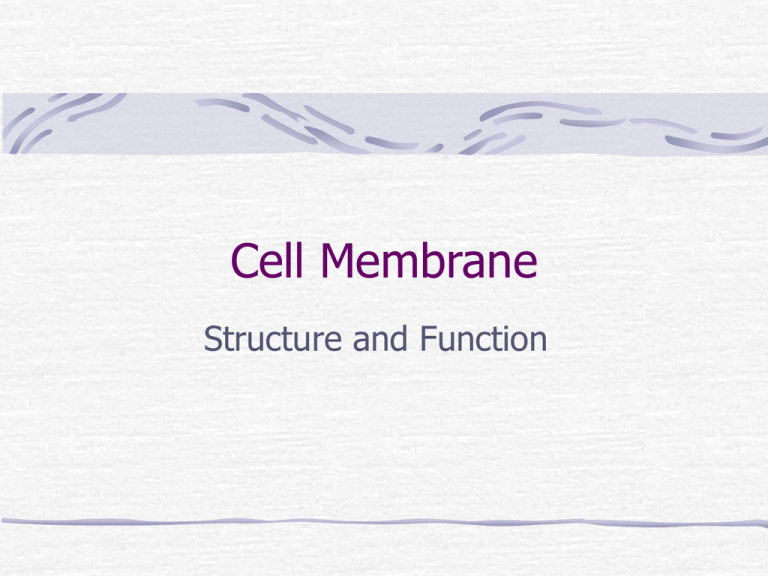
Cell Membrane Structure and Function Why is the plasma membrane necessary for cell survival? What characteristics should this barrier have? Fluid Mosaic Model: Phospholipid Bilayer (grout) Phospholipids Two fatty acid chains (non-polar) tails linked to a phosphate group (polar head) Double bonds increase fluidity Amphipathic molecule Fluidity Fluid because phospholipid molecules are not bonded to each other Fluid Mosaic Model: Phospholipid Bilayer Selectively Permeable Hydrophilic molecules cannot pass easily through Some very small or uncharged, lipid soluble molecules can pass through easily Cholesterol (in animal cells) Makes bilayer stronger, less flexible, and less permeable Fluid Mosaic Model: Mosaic of Proteins (tiles) Proteins Embedded in (integral) or attached to surface (peripheral) Three functional categories Transport proteins Receptor proteins Recognition proteins Membrane Related Health Issues Infectious disease Drug addiction Allergies Appetite signaling Nervous system disorders involving neurotransmitters Transport Across Membranes: Passive Transport Substances move “down” concentration gradient Difference in concentration No energy required Simple Diffusion Rate of simple diffusion Concentration gradient Molecule size Lipid solubility Examples Facilitated Diffusion Membrane transport membranes Channel proteins Carrier proteins Osmosis Diffusion of water across cell membrane Isotonic cell environment H2O concentration same in cell as around cell No net movement of water Hypertonic cell environment [solute] outside > [solute] inside cell Water will flow out of cell Cells shrivel Osmosis Hypotonic cell environment [solute] outside < [solute] inside cell Water will flow into cell Cells will swell Diffusion and Osmosis in the Human Body As a person becomes very dehydrated, the concentration of water in her blood decreases. In which direction will water move across the plasma membranes of her blood cells? What will happen to the volume of the cells as a consequence? Why is proper hydration important for multicellular organisms. Oops! You were cleaning out the aquariums in the biology lab and you accidentally placed the freshwater fish in the saltwater tank. What will happen to the cells of the fish? In some countries, human waste is used as a fertilizer. If produce is grown in this type of fertilizer, it is possible that it will be contaminated with the protozoan that causes amoebic dysentery. One method of removing the protist without ruining the food is to place the produce in a 5% salt solution. Explain how this would kill the protist. If you cleaned your lettuce this way, what would happen to the lettuce cells? How could you return them to normal? Transport Across Membranes: Active Transport with Proteins Use membrane proteins Span the phospholipid bilayer Use energy in the form of ATP Two binding sites Binds substance to be transported Binds ATP for energy Example – Na-K pump Membrane potential Transport Across Membranes: Endocytosis Pinocytosis “Cell drinking” nutrients Phagocytosis “cell eating” Macrophages and white blood cells Transport Across Membranes: Endocytosis Receptor-mediated endocytosis Selective process – receptor proteins Internalized in coated pit Hormone insulin Disorder: familial hyperchloesterolemia Connections Between Cells Desmosomes – anchoring junctions Adjacent cells held together by proteins and carbohydrates Skin, heart muscle, and neck of the uterus Tight junctions Impermeable junctions Epithelial cells lining the digestive tract Connections Between Cells Gap junctions Cells connected by hollow cylinders Transmembrane proteins Allow communication Heart and smooth muscle cells Plasmodesmata In plants





